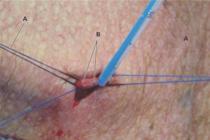Abstract
Access to the venous system is of vital importance for diagnosis and treatment of patients with the most varied range of clinical conditions, whether for taking blood samples or for infusion of solutions. In 1616, Harvey described the circulatory system on the basis of studies in animals and 4 decades later Sir Christopher Wren conducted the first intravenous infusions in living beings. Since then there has been constant evolution in access technique and infusion devices. Of particular note is the creation of long-term catheters in the 1970s, particularly totally implantable devices, which revolutionized cancer treatment, increasing both safety and comfort for oncology patients. The objectives of this article are to review historical data on vascular access and discuss the implantation technique and the main complications associated with procedures for placement and use of totally implantable venous access devices.
Keywords:
historical article; catheters; vascular access devices; infection; ultrasonography, interventional

 Thumbnail
Thumbnail
 Thumbnail
Thumbnail
 Thumbnail
Thumbnail
 Thumbnail
Thumbnail
 Thumbnail
Thumbnail
 Thumbnail
Thumbnail
 Thumbnail
Thumbnail






